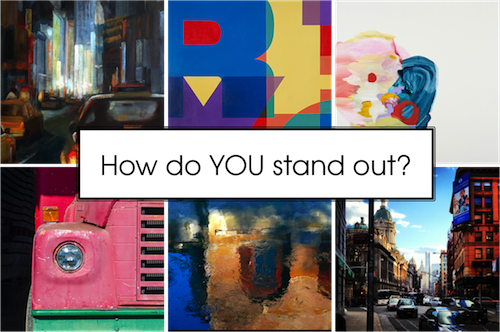by Carolyn Edlund
As an artist, you’d like to find potential customers and sell your work. But do you know what inspires them to buy?

Artwork doesn’t sell itself. That is a common misperception, usually resulting in low sales volume. So, what is the magic that will cause buyers to commit?
I recently had a conversation with Ashwin Muthiah about motivating buyers to make a purchase of your work.
“Quite often, making an art purchase makes people feel ‘cultured.’ They love the idea of acquiring art, and even becoming an art collector,” he says, “But intrinsic to the sale is understanding the story behind the artist and the work. Customers are not just buying something that looks good (although that’s naturally still important.) They are buying an experience, and that experience involves feeling that they understand and connect to the artist.”

“Furthermore, many times people don’t truly know what they want, and they appreciate receiving recommendations,” he adds. “We have found this to be key in driving sales. It’s much easier to be directed to a particular work or section on a page rather than just having to browse everything. Our curating team reviews collectors’ preferences and makes suggestions tailored to their interests.”
Being consultative is also a powerful way for artists who are selling directly to customers. After all, you are the expert on your work, and customers will appreciate your input on their selection. That conversation also indicates your interest in them, and your concern for the buyer’s wants and needs.
Is price the deciding factor when buying art? Actually, no. People who only care about price can simply buy wall décor at a discount store. However, it’s a good idea to spread your price points to appeal to a wider audience. This allows prospective customers to “buy in” and start acquiring your work at a more reasonable cost if they simply don’t have the budget to start purchasing your higher-priced art.
Then, keep those customers and build your art business by encouraging repeat sales. Those important names should stay on your list, and receive news about your new work and your events frequently.
Make the whole process of acquiring your artwork a very special event for your new purchaser by including extras that add value to the experience.
“Making buyers feel valued turns them into repeat customers,” says Muthiah. “If the experience of opening the package and seeing the artwork seems special, they are much more likely to make other purchases because they feel good about collecting your works. A letter to your new ‘collector’ with a Certificate of Authenticity, along with your artist statement, goes a long way towards making an acquisition of your art a memorable experience.”



This is such an interesting topic to me. I’ve always felt that people have to first emotionally connect with the piece of art, whether it’s a piece from a special place, a memory or something that just touches their soul, but I did like what you said here-“They are buying an experience, and that experience involves feeling that they understand and connect to the artist.” I do find that to be true, but the artwork has to speak to them so much that they are willing to get to know the artist then spend money on it.
Yes I completely agree that it helps when someone emotionally connects with a piece of art, but I feel like that isn’t always necessary. To some, that feeling of connection to a work is extremely important when buying a piece, and to others there might be a different part of the process that’s more important. Perhaps buying art locally is important to certain people or understanding an artist’s background. The emotional connection is definitely an important part of the art buying process!
Maybe. My daughter sells a lot of art to buyers who are looking for the right colour, size and frame to decorate their walls. Often she tells me that people will come in and buy the most expensive framing possible for an image that might only have cost $30 – $50. However, they have a connection with the reproduction as it reminds them of where they went or whom they met. It is the connection with the art that sells the framing, not its uniqueness. Just last Saturday she had a lady that came in with four lithos she had purchased on a cruise and finished up with over $4k for frames. Without the connection to the original pieces no sales of frames would have eventuated.
BTW. Do you as an artist sell your work framed? If not you could be missing out on more profit than on the sale of your original. But that is another story…
Neville, thanks for your thoughtful comment. I certainly think you echo the sentiment that the emotional factor has a lot to do with the sale.
I do suggest that artists offer their work framed, if possible. Shipping framed art is a hassle, though; as a rep for art publishers in a former life, I cannot tell you how much corner damage I witnessed, with cracked glass and damaged frames as a result. The framed must be properly packed, which isn’t always easy, especially for larger pieces.
Artists who sell framed work should always mark up the materials and pay themselves for the framing labor. Many times I have spoken to artists who pay themselves nothing except reimbursement for the frame itself. Every bit of time you put into your product must be paid for, and this is no exception.